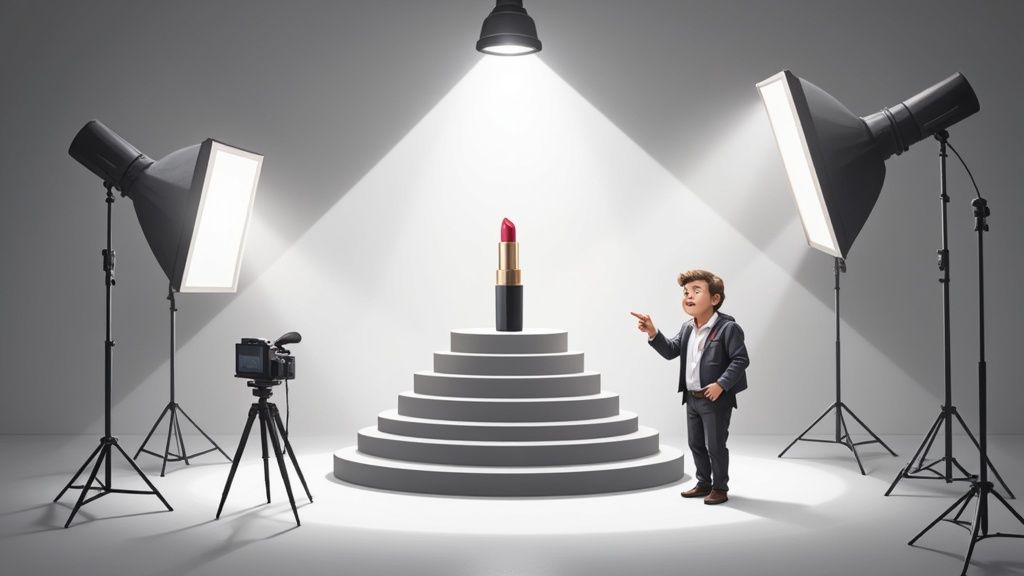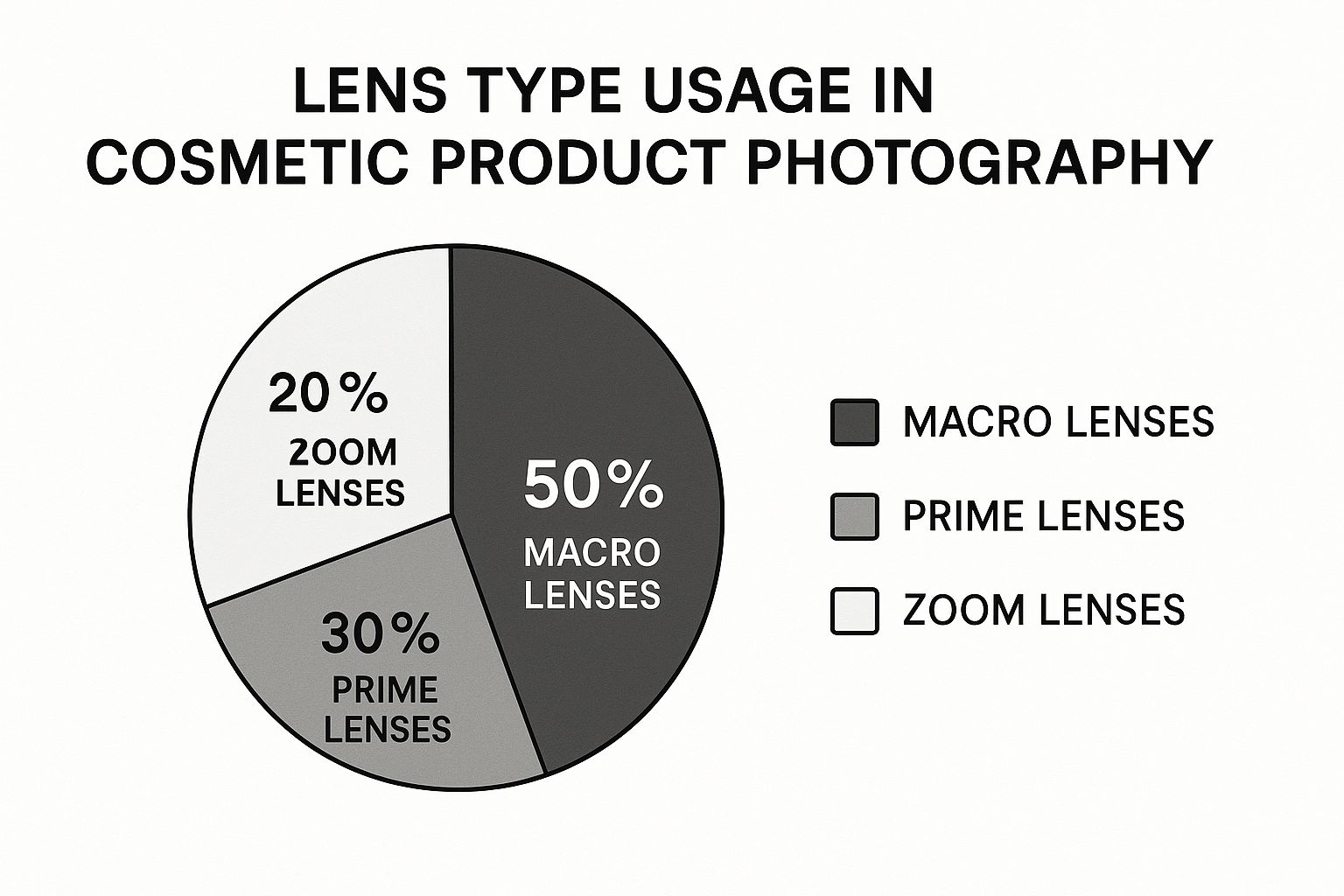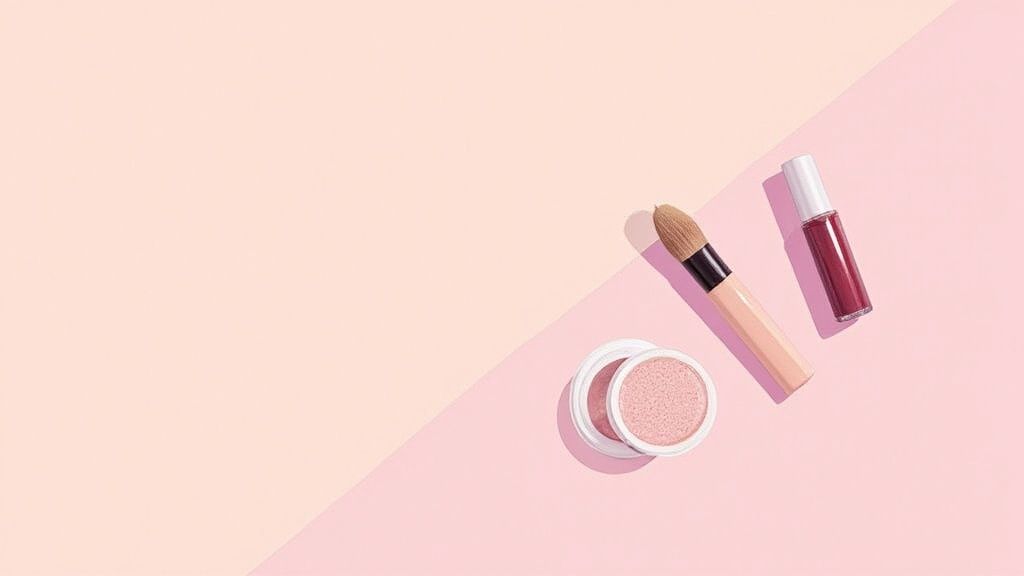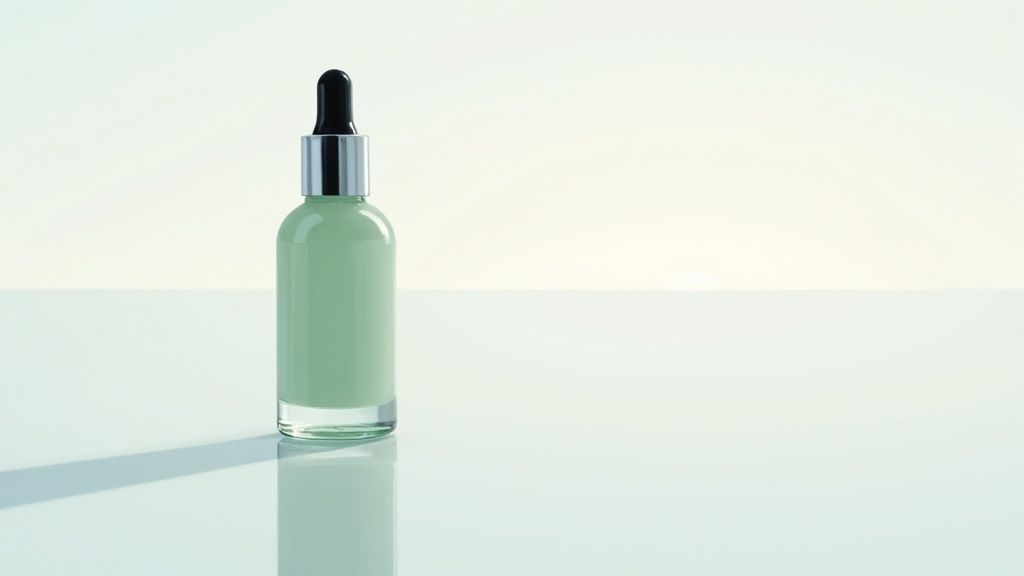Cosmetic Product Photography That Actually Sells Your Brand
 ProdShot Creator
ProdShot Creator
Why Your Product Photos Are Your Silent Sales Team
Imagine a potential customer scrolling through endless online beauty products. Their attention span is short, pausing only briefly on each image. In those few seconds, your cosmetic product photography does the talking. It’s your brand ambassador, working 24/7 to communicate your message. The key is to make those seconds count, turning casual browsers into paying customers.
Think about your own online shopping experiences. Let’s say you were looking for a new lipstick. Would a blurry, dimly lit photo make you click "add to cart"? Unlikely. What would grab your attention? A crisp, vibrant image that truly showcases the lipstick's color and texture. That's the power of strong cosmetic product photography. It allows customers to practically feel the product through their screen, bridging the gap between digital browsing and the real thing.
Visual Storytelling Converts Browsers into Buyers
Successful beauty brands understand this intuitively. They invest in high-quality visuals that tell a story. Think of it like this: each photo is a chapter, and together, they create a compelling narrative about the brand. Whether it's a luxurious feel or an everyday vibe, strategic photography choices communicate the brand's unique identity. These choices aren't random; they're carefully crafted to evoke specific emotions and create desire.
The beauty market is booming, expected to reach over $650 billion by 2025. This growth is largely driven by e-commerce and the influence of social media. This screenshot highlights the key trends shaping the industry, including the dominance of online sales and the power of social media. With most beauty consumers constantly engaging with digital content, compelling cosmetic product photography is more critical than ever. Want to learn more about these trends? Check out this insightful article: Beauty Industry Statistics.
From Struggling to Thriving: The Power of Visuals
Countless brands have seen incredible transformations, both online and in their bottom line, thanks to strategic cosmetic product photography. These aren't just pretty pictures; they're essential tools for building trust, showing value, and ultimately, driving sales. Think of professional photography as an investment, not a cost. By investing in compelling visuals, you're investing in the future of your brand. In the next section, we'll explore practical ways to build your photography arsenal without breaking the bank.
Building Your Photography Arsenal Without Breaking The Bank
Creating professional-looking cosmetic product photography can feel intimidating, a bit like trying to pilot a plane without any lessons. You might picture needing a huge studio packed with expensive gear. But surprisingly, you can get fantastic results without emptying your wallet. Think about it – many well-known photographers started small, working in kitchens, bedrooms, or even garages. Their secret? Clever use of light and composition.
Essential Equipment for Cosmetic Product Photography
So, what do you actually need to get started? This isn't a complete inventory, but it covers the essentials for stunning cosmetic product photography, balancing quality and affordability.
Camera: You don't need the fanciest DSLR on the market. A good smartphone camera, paired with the right techniques, can produce surprisingly effective images. For greater control and features, a mid-range DSLR or mirrorless camera is a worthwhile investment.
Tripod: A solid tripod is crucial for sharp, clear images, especially when lighting isn't ideal. It's like the anchor of your setup, keeping your framing consistent and preventing blurry photos.
Lighting: Natural light from a large window is ideal (and free!). Enhance it with inexpensive reflectors, like white foam boards, to manage shadows and create balanced lighting. Think of reflectors as your lighting assistants, directing the light where it needs to go.
Background: A plain white backdrop, like a roll of seamless paper or even a large piece of white poster board, creates a clean, professional aesthetic. This helps your product stand out and minimizes distractions.
Lenses: The infographic below shows the most common lens types used in cosmetic product photography. As you can see, macro lenses are popular for capturing tiny details, followed by prime and zoom lenses. The right lens can significantly elevate your images.

- Props and Styling Elements: Simple, affordable props can give your shots personality and context. Imagine textured fabrics, small mirrors, or natural elements like flowers or leaves. These small touches can have a big impact.
Building a Dedicated Photography Space
Consistency is important in cosmetic product photography. Having a designated area, even a small corner, can streamline your process and ensure similar results each time. This dedicated space doesn't need to be fancy. It just needs to be a controlled environment for your setup. Consider available natural light, equipment storage, and a clean background.
Maximizing Value and Minimizing Costs
Creating captivating visuals doesn't have to be expensive. To help you understand potential costs, check out this resource: Check out our guide on the costs of professional product photography. It provides a detailed breakdown of expenses, allowing you to make informed decisions. Prioritize investments that make the biggest difference, like lighting and lenses.
Learning basic photo editing with tools like Adobe Photoshop can also save you money on outsourcing. This empowers you to refine your images and create a consistent brand look without professional retouching costs.
To give you a better understanding of equipment options and costs, let's take a look at a comparison table:
Essential Photography Equipment Comparison
A comprehensive comparison of camera equipment, lighting setups, and accessories for different budget levels and photography needs
| Equipment Type | Budget Option | Professional Option | Key Features | Price Range |
| Camera | Smartphone with good camera | Full-frame DSLR or Mirrorless Camera | Image Quality, Sensor Size, Interchangeable Lenses | $500 - $3000+ |
| Tripod | Basic Tripod | Heavy-duty Tripod with advanced features | Stability, Adjustability, Durability | $20 - $200+ |
| Lighting | Natural light with reflectors | Studio strobe lights with softboxes | Light control, color accuracy, power output | $10 - $500+ |
| Background | Seamless paper roll or poster board | Professional backdrop system with various materials | Versatility, ease of use, size options | $15 - $150+ |
| Lenses | Kit lens or prime lens | Macro lens, specialized lenses | Sharpness, focal length, image stabilization | $100 - $1000+ |
As you can see, there are options available for every budget. Starting with budget-friendly equipment and gradually upgrading as your needs evolve is a smart approach.
In the next sections, we'll explore lighting and styling techniques, showing you how to transform everyday product shots into eye-catching visuals.
Making Light Work Magic For Your Beauty Products

This screenshot features the Strobist blog, a fantastic resource for learning about lighting in photography. The site focuses on using off-camera flash, which unlocks a world of creative control. The main takeaway? Mastering light, even with budget-friendly gear, can dramatically improve your cosmetic product photos.
Lighting is like the secret ingredient in great cosmetic product photography. It can elevate a simple lipstick from everyday to utterly luxurious, or reveal the intricate textures of a foundation. It’s the difference between a product looking flat and uninteresting, and vibrant and desirable. Think of lighting as makeup for your products. Just like contouring and highlighting enhance a face, the right lighting brings out the best in your beauty products.
Mastering Natural Light for Cosmetic Products
Natural light is a gift – it’s free and readily available! A large window serves as a huge, soft light source, beautifully diffusing light onto your product. But even natural light needs some direction. Direct sunlight can cast harsh shadows, making a product look less appealing. Imagine photographing a shimmering eyeshadow palette under direct sun. The intense light could wash out the delicate shimmer and create distracting bright spots.
To soften harsh light, use diffusers. Something as simple as a sheer white curtain or a piece of diffusion material draped over your window can make a world of difference. Picture a diffuser as a cloud softening the sun's glare. Reflectors, such as white foam boards, bounce light back onto the product, filling in shadows and creating a more even, flattering illumination. Reflectors are especially useful for products with fine details or complex textures.
Building a Studio Lighting Setup on a Budget
Natural light is wonderful, but a controlled studio setup offers unparalleled consistency and flexibility. This doesn't have to break the bank. You can achieve professional results with affordable continuous lights or speedlights. A simple two-light setup—a key light and a fill light—can create stunningly dimensional images. The key light, your primary light source, shapes the product, while the fill light softens any shadows.
Working with metallic packaging or glass containers presents unique challenges because of reflections. These surfaces act like mirrors, bouncing light unpredictably. Flags, which are simply black cards used to block light, can help manage those unruly reflections. A light tent diffuses light evenly, minimizing harsh reflections and creating a soft, almost dreamy light. This works perfectly for capturing the translucence of a serum or the glossy sheen of a lip gloss.
Handling Tricky Textures and Finishes in Cosmetic Photography
Different cosmetic products have their own personalities, reflected in their textures and finishes. Each calls for a unique lighting approach. A matte lipstick needs soft, diffused light to show off its velvety smooth texture, while a glossy lip gloss benefits from more direct light to highlight its shine. Powders can be especially challenging, as they can easily appear flat and dull. Angling your light source just slightly can create subtle shadows that define the powder’s texture, preventing it from looking lifeless.
By understanding how light interacts with different surfaces, you can create truly captivating cosmetic product photography. In the next section, we’ll explore how to build product scenes that tell your brand story.
Creating Product Scenes That Tell Your Brand Story

This image captures a growing trend: cosmetic photography that moves past plain product shots and creates scenes that truly connect with shoppers. It shows the product in a lifestyle context, giving you a glimpse of how it fits into a daily routine. This adds depth and character, turning a simple product image into a mini-story.
Good cosmetic product photography isn't just about taking a picture of your latest lipstick or serum. It's about building a visual narrative that resonates. Imagine you're setting a stage. Everything matters—the backdrop, the props, the colors, how it's all arranged. These elements work together to communicate your brand's message and make your products irresistible.
The Psychology of Styling in Cosmetic Product Photography
Styling your cosmetic products is a lot like choosing the perfect outfit. You want something that expresses your style, highlights your best features, and makes you feel great. In the same way, the right styling choices in your product photography can elevate your product and connect with your ideal customer.
Backgrounds: A clean, simple background, like a white sheet of paper or a neutral backdrop, lets your product shine. But don't be afraid to play with textures and colors that reflect your brand.
Props: Thoughtfully chosen props can add context and personality. Imagine photographing a natural skincare line. Adding elements like flowers, leaves, or stones can really emphasize that connection to nature.
Composition: How you arrange your products and props within the frame makes a big difference. The rule of thirds and other composition techniques can help you create balanced and engaging photos.
Color Choices, Spatial Relationships, and Guiding Attention
Think of the viewer's eye like a traveler exploring your image. You want to guide them to the highlights—your products. Colors, how things are spaced, and other styling choices are like signposts, directing attention where you want it to go. A contrasting color for your product against a neutral background can make it instantly stand out.
Minimalist vs. Lifestyle Setups
Some brands go for a clean, minimalist look, letting the product speak for itself. Others create elaborate lifestyle scenes showing the product in use. There's no single right answer. The key is choosing a style that matches your brand and speaks to your target audience. A luxury skincare brand might choose a minimalist approach to project sophistication, while a more playful makeup brand might use lifestyle setups to showcase the product's versatility.
Check out some inspiring beauty product photos for ideas: You might be interested in: Beauty Product Photos. This gallery showcases a variety of styling approaches and can spark your creativity. Also, stay aware of industry trends. In 2025, authenticity and inclusivity are shaping cosmetic photography. Brands are shifting away from heavily edited images toward more natural visuals—featuring real skin textures, diverse skin tones, and a range of body types. Inclusive photography isn't just a nice-to-have; it's what consumers expect. Discover more insights.
Practical Styling Techniques and Mistakes to Avoid
Creating multiple looks without breaking the bank on props is a smart move, especially for smaller businesses. Think of your props like a capsule wardrobe—a few versatile items you can mix and match to create many different outfits. A small collection of props can be rearranged and reused for various product shots. But watch out for styling missteps that can actually hurt sales. Cluttered backgrounds, distracting props, and poor composition can make your products look less appealing. In the next section, we'll explore the world of post-processing.
Post-Processing That Enhances Without Overdoing It

This screenshot shows Adobe Photoshop, a stalwart for image editing. Notice the sheer number of tools! While Photoshop offers immense power, the key with cosmetic product photos is subtle refinement, not a complete transformation.
Think of post-processing like applying makeup. You're enhancing natural features, not creating a whole new face. You're bringing out the image's best, ensuring it truly reflects the product. This balance between enhancement and authenticity is key for earning customer trust.
The Art of Subtle Enhancements in Cosmetic Product Photography
Post-processing isn't about making products look fake. It's about presenting them in the best possible light – quite literally! Usually, the first step is color correction. This ensures the photo's colors match the actual product.
Imagine a vibrant red lipstick. Bad lighting during the shoot might make it look dull or too orange in the photo. Color correction fixes that, restoring the true-to-life vibrancy.
Next is adjusting brightness and contrast. This can dramatically change how a product stands out. It's like adjusting the lighting in a room. More brightness can make the image feel airy and welcoming, while contrast adds depth.
Maintaining Accurate Color Representation and Brand Consistency
Consistent visuals across your marketing are crucial for brand identity. In product photography, this means sticking to a defined visual style. Think specific color palettes, lighting styles, or even the props you use. This consistency helps customers instantly recognize your brand.
For example, if your brand is minimalist, your photos should be too. Clean backgrounds, simple props, and a focus on the product itself all communicate that minimalism. Post-processing helps maintain this consistency across every image.
AI-Powered Tools and the Future of Cosmetic Product Photography
Cosmetic product photography is constantly changing, shaped by technology and consumer trends. AI-powered tools are playing a bigger role, offering exciting new ways to enhance and optimize images. These tools can automate background removal, color correction, and image resizing, saving you time and effort. Learn more about these services here: Discover more about product photo editing services. Plus, the rise of social commerce on platforms like TikTok and Amazon is changing how people discover beauty products, emphasizing the need for fresh photography solutions. Discover more insights.
Avoiding Common Editing Mistakes
While post-processing is powerful, it’s easy to overdo it. One common mistake is over-retouching. This can make products look artificial and unrealistic, damaging customer trust. Think of overly airbrushed magazine images. They may look “perfect,” but they often lack authenticity. The aim is enhancement, not creating a fantasy.
Another pitfall is inconsistent editing. This makes your brand look unprofessional and disorganized. Imagine some product photos bright and airy, while others are dark and moody. This inconsistency is confusing. A consistent editing style, whether bright and cheerful or dark and dramatic, strengthens your brand.
Adapting Your Photos For Every Platform's Sweet Spot
Think of social media and online marketplaces like different countries. Each one has its own language and customs. Your cosmetic product photos need to speak the local lingo to truly connect. A picture that works wonders on Instagram might fall flat on Amazon or TikTok. Imagine trying to sell luxury lipstick with the same image on TikTok as you would on a high-end retail site – it simply wouldn't resonate.
Understanding Platform Nuances in Cosmetic Product Photography
Just as a traveler adapts to new cultures, you need to tailor your visuals. This isn't about changing your product; it's about showcasing it in the best light for each platform.
Instagram: Instagram is a visual playground. High-quality, lifestyle images are king. Capture the essence of your brand and connect with your audience through stylish shots that tell a story. Remember, Instagram loves engagement (likes, comments, shares), so aim for captivating visuals.
This screenshot from Instagram Business underscores the power of knowing your audience and creating content that speaks directly to them. Tailor your content, use best practices, and track performance using analytics.
Amazon: On Amazon, clarity is paramount. The platform has specific image guidelines, often requiring a plain white background and detailed product shots. Focus on providing potential buyers with the practical information they need. Think crisp, clean, and informative.
TikTok: TikTok thrives on short, engaging videos. Behind-the-scenes glimpses, quick tutorials, and user-generated content perform exceptionally well. Think dynamic, authentic, and relatable. Show your products in action!
Building a Versatile Photo Library for Your Cosmetic Products
Building a varied photo library is like having a well-stocked toolkit. You'll have the right visual for any situation, whether it's a social media post, an email campaign, or a product listing. This doesn't mean separate photoshoots for every platform. Instead, capture a range of shots during your sessions:
- Close-up shots: These are your go-to for showcasing textures and fine details.
- Lifestyle shots: Perfect for Instagram and other visually driven platforms.
- Product-only shots on a white background: Essential for Amazon and similar e-commerce sites.
- Short video clips: Ideal for TikTok and Instagram Reels.
Optimizing Your Cosmetic Product Photography for Each Platform
Every platform has its own technical specs. Optimizing your images isn't just a technical detail; it can significantly impact your visibility and engagement. Think of it as fine-tuning your message for maximum impact.
To help illustrate these requirements, the table below outlines the platform-specific image dimensions, file formats, key features, and optimization tips.
Platform-Specific Image Requirements
Technical specifications and best practices for cosmetic product photography across major social media and e-commerce platforms
| Platform | Image Dimensions | File Format | Key Features | Optimization Tips |
| 1080 x 1080 pixels (square) or 1080 x 1350 pixels (portrait) | JPEG or PNG | High-quality, visually appealing | Use relevant hashtags, engage with comments | |
| Amazon | At least 1000 x 1000 pixels | JPEG, TIFF, GIF | Clear product shots on a white background | Optimize images for fast loading times |
| TikTok | 1080 x 1920 pixels (vertical) | MP4 or MOV | Short, engaging videos | Use trending sounds and hashtags |
As shown in the table, optimizing your images for each specific platform is crucial for success.
By adapting your cosmetic product photography, you can significantly broaden your reach, connect with your target audience, and ultimately, boost sales. In the next section, we'll explore how to measure the effectiveness of your photography strategy.
Measuring What Actually Matters For Your Photography ROI
Beautiful product photos are eye-catching, no doubt. But at the end of the day, they need to bring in sales. Think of your cosmetic product photography like any other marketing campaign. You wouldn't pour money into ads without tracking their performance, right? The same principle applies to your product images. You need to measure their impact and use that data to refine your visual strategy.
Beyond Vanity Metrics: Focusing on Real Results
Social media makes it easy to get fixated on vanity metrics like likes and follower counts. These numbers might feel good, but they don't always correlate with actual business growth. When it comes to cosmetic product photography, the metrics that truly matter are those directly tied to your bottom line – sales.
Click-Through Rate (CTR): How often are people clicking on your product photos? A higher CTR suggests your images are effectively grabbing attention and directing traffic to your product pages.
Conversion Rate: Of the people who land on your product page, how many actually complete a purchase? Strong visuals are essential for converting browsers into buyers.
Bounce Rate: How quickly are visitors leaving your product page after arriving? A high bounce rate could indicate that your photos aren't accurately representing your products, or that your page isn't engaging enough to keep them around.
Tracking and Analyzing Your Photography Performance
Setting up some simple tracking mechanisms can reveal how your photography choices affect these key metrics. Tools like Google Analytics can provide invaluable insights into user behavior on your website.
This screenshot gives you a peek into the wealth of data available through Google Analytics. It shows crucial metrics like user acquisition, behavior, and conversions – all vital for understanding how your cosmetic product photography contributes to your overall business performance. By analyzing this data, you can pinpoint which images are driving the most traffic and conversions.
A/B Testing: Finding the Visuals That Convert
A/B testing is a powerful method for comparing different versions of your product photos. It's like running a scientific experiment for your visuals. You present two different images to similar customer groups and track which one performs better based on CTR, conversion rate, and other relevant metrics.
Test different backgrounds: Does a clean white background perform better than a lifestyle setting?
Experiment with lighting: Does soft, diffused light outshine dramatic lighting?
Vary styling choices: Do simple props resonate more than elaborate scenes?
By consistently testing and analyzing, you can identify the visual elements that truly connect with your target audience and drive sales.
Building a Data-Driven Photography Strategy
Over time, A/B testing and data analysis build a treasure trove of knowledge about what works and what doesn't. This allows you to create a data-driven approach to your cosmetic product photography. Each photoshoot becomes a strategic investment, guided by data-backed insights, not just creative intuition.
Want to turn your smartphone photos into professional-quality product images without spending a fortune? Check out ProdShot. With its AI-powered editing, ProdShot automatically removes backgrounds, enhances lighting, and creates stunning visuals in seconds. Streamline your workflow and boost your sales with captivating product photography.
Subscribe to my newsletter
Read articles from ProdShot Creator directly inside your inbox. Subscribe to the newsletter, and don't miss out.
Written by
